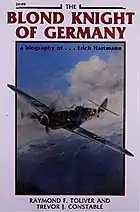The Blond Knight of Germany
The Blond Knight of Germany is a book by the American authors Trevor J. Constable and Raymond F. Toliver dedicated to the life and career of the German fighter pilot of World War II, Erich Hartmann. Originally released in the United States in 1970, it was published in Germany the next year, as Holt Hartmann vom Himmel!.
 | |
| Author | Trevor J. Constable Raymond F. Toliver |
|---|---|
| Country | United States (1970) Germany (1971), as Holt Hartmann vom Himmel! |
| Language | English German |
| Genre | Historical fiction |
| Publisher | Tab Aero (1st English edition) Motorbuch Verlag (1st German edition) |
Publication date | 1970 |
| Media type | |
The Blond Knight was a commercial success and enjoyed a wide readership among both the American and the German public. The book has been criticised by American and German historians as ahistorical and misleading in recent historiography.
Background
Trevor J. Constable and Raymond Toliver are American authors who produced 10 non-fiction books on the fighter aces of World War II. Toliver is a former U.S. Air Force pilot and official historian of the American Fighter Aces Association.[1]
Criticism
The Blond Knight of Germany was criticised by historians Ronald Smelser and Edward J. Davies in their work The Myth of the Eastern Front as one of the key works that promoted the myth of the "clean Wehrmacht". They described the book as a "hallmark of romanticization", with its "insidious" title that suggested medieval chivalry that "not only fails to characterize the conduct of the Wehrmacht during the Soviet-German war, but, indeed, marks its opposite".[2]
The historian Klaus Schmider notes that the authors are "sympathetic" to Hartmann, and that the book "tip[s] over into out-and-out hero worship".[3]
The historian Jens Wehner notes that the German-language version of the book, released in 1971 as Holt Hartmann vom Himmel! Die Geschichte des erfolgreichsten Jagdfliegers der Welt, was immensely popular in Germany, but contained serious flaws in terms of presentation of historical realities. These included the uncritical borrowing from the Nazi propaganda elements of the Fliegerassen ("aces") and stereotypes about the Soviet Union. According to Wehner, the latter could be traced to the prevailing attitudes during the Cold War. Further, the political and social consequences of World War II were completely ignored.[4]
References
Citations
- Parkinson 1966.
- Smelser & Davies 2008, pp. 170–173.
- Schmider 2009.
- Notheisen 2017.
Bibliography
- Laura Notheisen (31 January 2017). "So war der deutsche Landser. Die populäre und populärwissenschaftliche Darstellung der Wehrmacht" [So was the German Landser: The popular culture and popular history representation of the Wehrmacht]. H-Soz-Kult (in German). Retrieved 12 March 2016. H-Soz-Kult
- Parkinson, Russell J.; Toliver, Raymond F.; Constable, Trevor (Spring 1966). "Fighter Aces. by Raymond F. Toliver; Trevor Constable". Military Affairs. Society for Military History. 30 (1): 51. doi:10.2307/1985471. JSTOR 1985471.
- Pilkington, Mark (June 23, 2005). "Life: Letters: Phantom flyers: Far out". The Guardian. London. p. 10.
- Schmider, Klaus (January 2009). "The Last of the First: Veterans of the Jagdwaffe Tell their Story". The Journal of Military History. Society for Military History. 73 (1): 231–249. doi:10.1353/jmh.0.0179.
- Smelser, Ronald; Davies, Edward J. (2008). The Myth of the Eastern Front: The Nazi-Soviet War in American Popular Culture. New York: Cambridge University Press. ISBN 978-0-521-83365-3.}